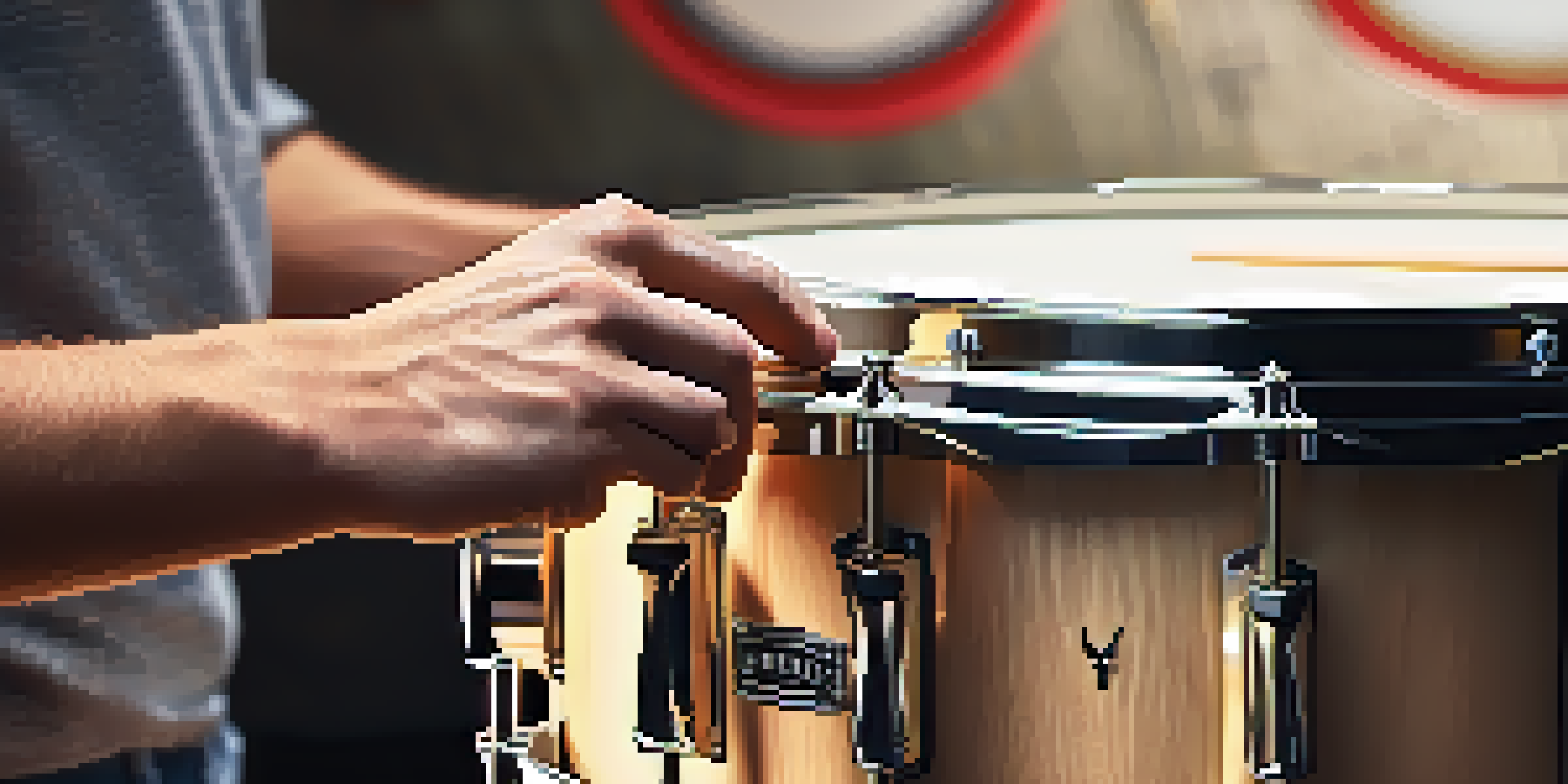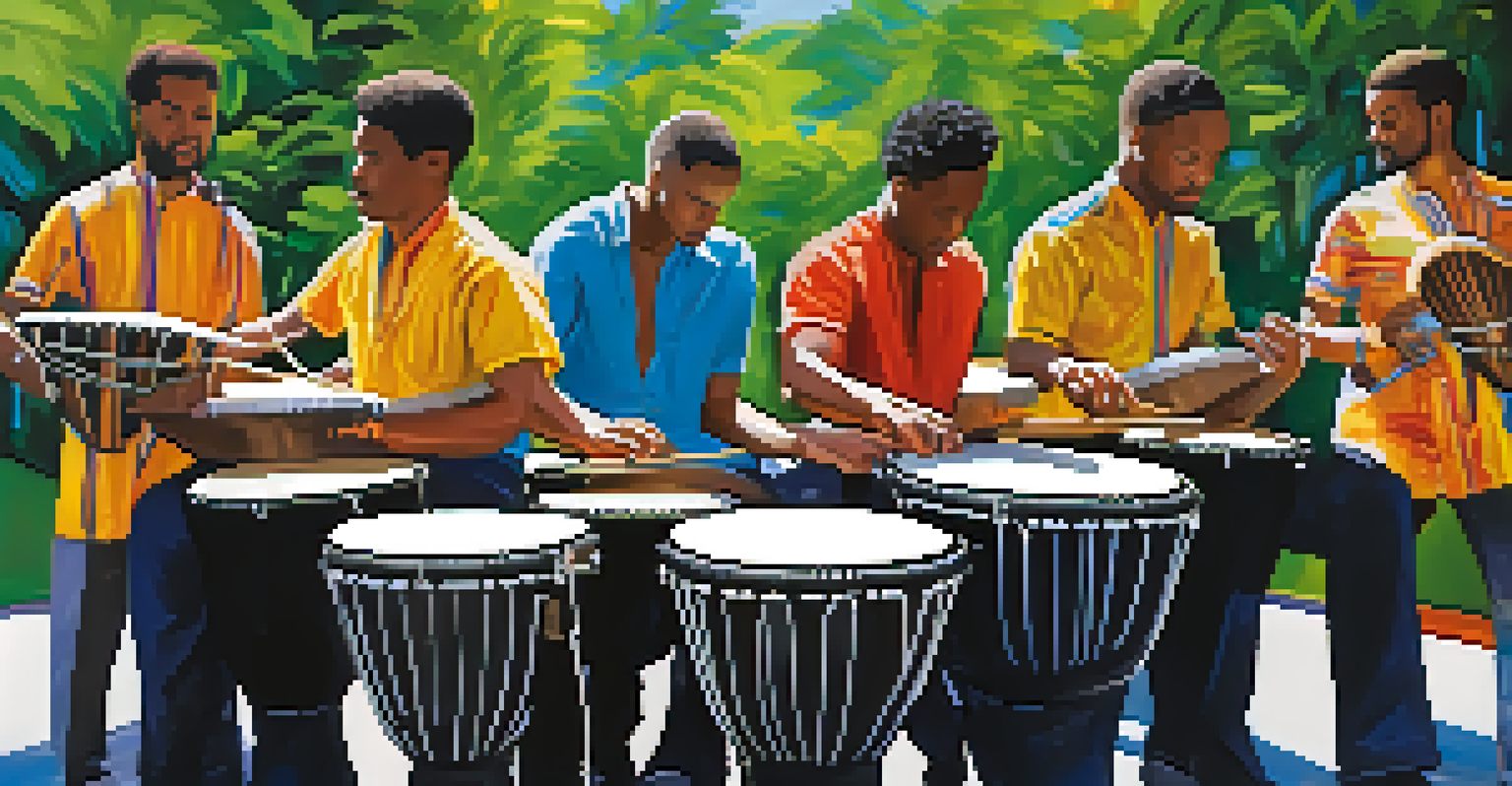Exploring Damping Techniques for Percussion Instruments

Understanding Damping in Percussion Instruments
Damping is a crucial technique used in percussion to control sound. It involves reducing the resonance and sustain of an instrument, which can help achieve a desired tonal quality. This technique is particularly important in genres where clarity and precision are essential, such as classical and jazz music.
The best musicians know how to use silence to enhance their sound.
For percussionists, understanding how damping affects sound can be a game-changer. Imagine striking a snare drum; without damping, the sound may linger too long and become muddled. By applying damping techniques, musicians can create a sharper, more articulate sound that enhances their overall performance.
In the world of percussion, various damping methods exist, each offering unique effects. From physical dampening materials to playing techniques, these methods allow musicians to tailor their sound to match their artistic vision.
Common Damping Techniques for Drums
One of the most popular damping techniques for drums involves using dampening pads or gels. These materials can be placed directly on the drumhead to absorb excess vibrations and control resonance. For example, a small piece of foam can significantly reduce the overtones produced by a tom drum, resulting in a more focused sound.

Another common method is using tape or cloth to mute specific areas of the drumhead. Musicians often experiment with different placements to achieve their desired tone. The beauty of this approach lies in its simplicity and the immediate effect it has on the drum's sound.
Damping Controls Sound Quality
Damping techniques are essential for percussionists to manage resonance and sustain, enhancing tonal clarity in their performances.
Additionally, the drummer's playing style can also influence damping. Techniques like rim shots or ghost notes create different levels of resonance, which can either enhance or reduce sustain. Understanding how to manipulate these playing techniques is essential for achieving the perfect sound.
Using Mutes and Silencers for Control
Mutes and silencers are effective tools for controlling sound in percussion instruments. These devices are designed to be placed on the instrument, minimizing volume while still allowing for practice and performance. For instance, rubber mutes can be used on cymbals to reduce their brightness without sacrificing the feel of playing.
Music is the shorthand of emotion.
Percussionists often turn to practice pads as a form of damping, especially for snare drums. These pads simulate the feel of a drum while significantly lowering the volume, making them perfect for quiet practice sessions. This allows musicians to hone their skills without disturbing others.
It's essential to choose the right type of mute or silencer based on the specific instrument and playing context. The choice can greatly impact the sound produced, so experimentation is key. Finding the right balance between volume and tonal quality can elevate a performance to new heights.
Natural Damping Techniques: The Role of Hand and Body
Damping isn't just about using materials; it can also be achieved through the musician's body. For example, a drummer can use their hands or arms to mute a cymbal after striking it. This technique allows for quick changes in sound dynamics and can be particularly effective in live performances.
Similarly, using the foot to control a bass drum can create varied damping effects. By partially closing the pedal, drummers can shorten the sustain of each stroke, achieving a punchy, staccato sound. This interplay between body and instrument demonstrates the physicality of percussion.
Experiment with Damping Materials
Different damping materials like felt and foam can significantly alter the sound of percussion instruments, allowing musicians to personalize their sound.
Understanding how to use one's body for damping can lead to more expressive playing. It encourages musicians to explore their instrument's full range and discover new sounds. This approach not only enhances technical skills but also fosters creativity in performance.
Exploring Electronic Damping Techniques
In the modern world of music, electronic damping techniques are becoming increasingly popular. Electronic drum kits often come equipped with built-in sound modulation features that allow musicians to adjust the sustain and decay of each sound. This level of control can be particularly useful in electronic music genres.
Software tools and digital audio workstations (DAWs) also provide damping options for recorded percussion sounds. Musicians can apply effects like reverb, compression, and EQ to shape the sound during the mixing process. This flexibility allows for precise sound design that can elevate a track's production quality.
Moreover, integrating electronic elements with traditional percussion can lead to innovative soundscapes. By combining analog and digital techniques, musicians can create unique textures that push the boundaries of conventional percussion performance.
Experimenting with Damping Materials
The choice of damping materials can have a significant impact on the sound produced by percussion instruments. Musicians often experiment with various materials like felt, foam, and cloth to find the right combination that suits their style. Each material offers a distinct tonal character, allowing for personalized sound shaping.
For instance, felt is known for its ability to soften sound without completely muting it, making it a favorite among orchestral percussionists. In contrast, foam can provide a more aggressive damping effect, perfect for rock or pop drummers looking for punchy sounds. This experimentation can lead to a deeper understanding of an instrument's sonic potential.
Utilize Body for Natural Damping
Musicians can achieve effective damping through body techniques, such as muting with hands or feet, adding dynamic control to their playing.
Ultimately, the key is to explore and discover what works best for your playing style. By trying different materials and techniques, percussionists can unlock new dimensions in their music, creating a richer and more dynamic sound.
Damping Techniques for Unique Percussion Instruments
While many damping techniques are common to standard percussion instruments, unique instruments may require specialized approaches. For example, hand drums like congas or djembe benefit from palm muting techniques, where players use their hands to dampen the sound after striking. This not only controls sustain but also adds a rhythmic element to the music.
Instruments like tambourines or shakers may use slightly different damping methods. Players can tilt the instrument or cover its holes to manipulate sound and sustain. This adaptability showcases the versatility of percussion instruments and the creativity of the musicians who play them.

Exploring damping techniques tailored to specific instruments can inspire new musical ideas. By understanding the unique characteristics of each instrument, percussionists can develop their signature sound and style, making their performances stand out.